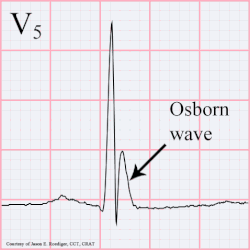

A J wave — also known as Osborn wave, camel-hump sign, late delta wave, hathook junction, hypothermic wave,[1] K wave, H wave or current of injury — is an abnormal electrocardiogram finding.[2]
J waves are positive deflections occurring at the junction between the QRS complex and the ST segment,[3][4] where the S point, also known as the J point, has a myocardial infarction-like elevation.
- ^ Aydin M, Gursurer M, Bayraktaroglu T, Kulah E, Onuk T (2005). "Prominent J wave (Osborn wave) with coincidental hypothermia in a 64-year-old woman". Tex Heart Inst J. 32 (1): 105. PMC 555838. PMID 15902836.
- ^ Maruyama M, Kobayashi Y, Kodani E, et al. (2004). "Osborn waves: history and significance". Indian Pacing Electrophysiol J. 4 (1): 33–9. PMC 1501063. PMID 16943886. Archived from the original on 2011-06-15. Retrieved 2008-12-20.
- ^ "ecg_6lead018.html". Retrieved 2008-12-20.
- ^ "THE MERCK MANUAL OF GERIATRICS, Ch. 67, Hyperthermia and Hypothermia, Fig. 67-1". Retrieved 2008-12-20.